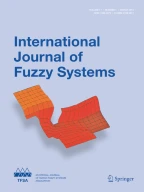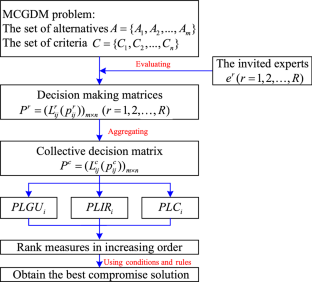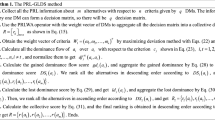An Improved PL-VIKOR Model for Risk Evaluation of Technological Innovation Projects with Probabilistic Linguistic Term Sets

Risk evaluation is a primary but important task for technological innovation projects and this task is a multiple criteria group decision-making (MCGDM) process with probabilistic uncertainty and fuzzy uncertainty. Compromise programming decision-making methods with probabilistic linguistic term sets (PLTSs) are more appropriate for risk evaluation of technological innovation projects. This paper proposes a new approach named improved probabilistic linguistic-vise kriterijumska optimizacija kompromisno resenje (PL-VIKOR) method with probabilistic linguistic term sets for risk evaluation of technological innovation projects. Firstly, by fully considering both the relationship between each alternative and the positive ideal solution and the relationship between each alternative and negative ideal solution, the improved PL-VIKOR method for dealing with MCGDM problems is developed to make up the deficiency of the traditional PL-VIKOR method. Then, the improved PL-VIKOR method is applied to solve a practical MCGDM problem with probabilistic linguistic term sets involving the risk evaluation of technologically innovative projects for venture capital. Finally, we make some comparative analyses between the improved PL-VIKOR method and some existing methods to analyze the advantages and disadvantages of the proposed method. The results reflect that the improved PL-VIKOR method is more reasonable when calculating the distance measure between two PLTSs, and it can make the risk evaluation of technological innovation project MCGDM with PLTSs more objective.
This is a preview of subscription content, log in via an institution to check access.
Access this article
Subscribe and save
Springer+ Basic
€32.70 /Month
- Get 10 units per month
- Download Article/Chapter or eBook
- 1 Unit = 1 Article or 1 Chapter
- Cancel anytime
Buy Now
Price includes VAT (France)
Instant access to the full article PDF.
Rent this article via DeepDyve

Similar content being viewed by others

Probabilistic reliable linguistic term sets applied to investment project selection with the gained and lost dominance score method
Article 27 April 2021

Joint Treatment of Imprecision and Randomness in the Appraisal of the Effectiveness and Risk of Investment Projects
Chapter © 2017

New Methods for Feasibility Analysis of Investment Projects in Uncertain Environments
Chapter © 2022
Explore related subjects
Abbreviations
VIse kriterijumska optimizacija kompromisno resenje
Probabilistic linguistic-vise kriterijumska optimizacija kompromisno resenje
Probabilistic linguistic term sets
Multiple criteria group decision-making
Linguistic term set
Analytic hierarchy process
Tunnel boring machine
Failure modes and effects analysis
Decision-Making Trial and Evaluation Laboratory
Probabilistic linguistic-technique for order performance by similarity to ideal solution
Probabilistic linguistic-multi-objective analysis by ratio analysis plus the full multiplicative form
Probabilistic linguistic-linear programming techniques for multidimensional analysis of preference
Probabilistic linguistic-gained and lost dominance score
Probabilistic linguistic-organisation rangement etAynhése de données relationnelles
Probabilistic linguistic-elimination et choix traduisant la realite
Probabilistic linguistic-preference ranking organization method for enrichment evaluations
Probabilistic linguistic-qualitative flexible
Probabilistic linguistic-grey relational analysis
Probabilistic linguistic-double normalization-based multiple aggregation
References
- Bromiley, P., Rau, D., McShane, M.K.: Can strategic risk management contribute to enterprise risk management? A strategic management perspective. Soc. Sci. Electron. Pub. 2016, 140–156 (2016) Google Scholar
- Cavaco, N.M., Machado, V.C.: Sustainable competitiveness based on resilience and innovation—an alternative approach. Int. J. Manag. Sci. Eng. Manag. 10(2), 155–164 (2015) Google Scholar
- Malik, M.F., Zaman, M., Buckby, S.: Enterprise risk management and firm performance: role of the risk committee. J. Contemp. Account. Econ. 16(1), 100178 (2020) ArticleGoogle Scholar
- Lechner, P., Gatzert, N.: Determinants and value of enterprise risk management: empirical evidence from Germany. Soc. Sci. Electr. Pub. 24(10), 867–887 (2017) Google Scholar
- Galli, B.J., Battiloro, G.: Economic decision-making and the impact of risk management: How they relate to each other. Int. J. Serv. Sci. Manag. Eng. Tech. 10(3), 1–13 (2019) Google Scholar
- Ebrahimnejad, S., Mousavi, S., Tavakkoli-Moghaddam, R., Heydar, M.: Evaluating high risks in large-scale projects using an extended VIKOR method under a fuzzy environment. Int. J. Indust. Eng. Comp. 3(3), 463–476 (2012) Google Scholar
- Biswas, T.K., Zaman, K.: A fuzzy-based risk assessment methodology for construction projects under epistemic uncertainty. Int. J. Fuzzy Syst. 21(4), 1221–1240 (2019) ArticleMathSciNetGoogle Scholar
- Bi, K., Huang, P., Ye, H.: Risk identification, evaluation and response of low-carbon technological innovation under the global value chain: a case of the Chinese manufacturing industry. Technol. Forecast. Soc. Chang. 100, 238–248 (2015) ArticleGoogle Scholar
- Abdel-Basset, M., Gunasekaran, M., Mohamed, M., Chilamkurti, N.: A framework for risk assessment, management and evaluation: economic tool for quantifying risks in supply chain. Futur. Gener. Comp. Syst. 90, 489–502 (2019) ArticleGoogle Scholar
- Peng, H.G., Zhang, H.Y., Wang, J.Q.: Cloud decision support model for selecting hotels on TripAdvisor.com with probabilistic linguistic information. Int. J. Hosp. Manag. 68, 124–138 (2018) ArticleGoogle Scholar
- Peng, H.G., Wang, J.Q.: Hesitant uncertain linguistic Z-numbers and their application in multi-criteria group decision-making problems. Int. J. Fuzzy Syst. 19(5), 1300–1316 (2017) ArticleGoogle Scholar
- Cho, H.-N., Choi, H.-H., Kim, Y.-B.: A risk assessment methodology for incorporating uncertainties using fuzzy concepts. Reliab. Eng. Syst. Saf. 78(2), 173–183 (2002) ArticleGoogle Scholar
- Faizi, S., Rashid, T., Sałabun, W., Zafar, S., Wątróbski, J.: Decision making with uncertainty using hesitant fuzzy sets. Int. J. Fuzzy Syst. 20(1), 93–103 (2018) ArticleMathSciNetMATHGoogle Scholar
- Pang, Q., Wang, H., Xu, Z.: Probabilistic linguistic term sets in multi-attribute group decision making. Inf. Sci. 369, 128–143 (2016) ArticleGoogle Scholar
- Xian, S., Chai, J., Yin, Y.: A visual comparison method and similarity measure for probabilistic linguistic term sets and their applications in multi-criteria decision making. Int. J. Fuzzy Syst. 21(4), 1154–1169 (2019) ArticleMathSciNetGoogle Scholar
- Xu, Z., He, Y., Wang, X.: An overview of probabilistic-based expressions for qualitative decision-making: techniques, comparisons and developments. Int. J. Mach. Learn. Cybern. 10(6), 1513–1528 (2019) ArticleGoogle Scholar
- Liao, H.C., Mi, X.M., Xu, Z.S.: A survey of decision-making methods with probabilistic linguistic information: bibliometrics, preliminaries, methodologies, applications and future directions. Fuzzy Optim. Decis. Mak. 19, 81–134 (2019) ArticleMathSciNetMATHGoogle Scholar
- Mi, X.M., Liao, H.C., Wu, X.L., Xu, Z.S.: Probabilistic linguistic information fusion: a survey on aggregation operators in terms of principles, definitions, classifications, applications, and challenges. Int. J. Intell. Syst. 35(3), 529–556 (2020). https://doi.org/10.1002/int.22216ArticleGoogle Scholar
- Choi, Y., Ye, X., Zhao, L., Luo, A.C.: Optimizing enterprise risk management: a literature review and critical analysis of the work of? Wu and Olson. Ann. Oper. Res. 237(2), 281–300 (2015) MathSciNetMATHGoogle Scholar
- Tüysüz, F., Kahraman, C.: Project risk using a fuzzy analytic hierarchy process: an application to information technology projects. Int. J. Intell. Syst. 21(6), 559–584 (2006) ArticleMATHGoogle Scholar
- Yazdi, M., Kabir, S.: A fuzzy Bayesian network approach for risk analysis in process industries. Process Saf. Environ. Protect. 111, 507–519 (2017) ArticleGoogle Scholar
- Wenying, Y., Jing, J., Liang, Z., Changwei, Y., Zonghao, L., Xueyan, G.: Application of BP neural network model in risk evaluation of railway construction. Complexity 2019, 1–12 (2019) Google Scholar
- Huang, Y.S., Qi, J.X., Zhou, J.H.: Method of risk discernment in technological innovation based on path graph and variable weight fuzzy synthetic evaluation. Inter. Conf. Fuzzy Syst. Knowl. Discov. 635–644, 2005 (2005) Google Scholar
- Hyun, K.-C., Min, S., Choi, H., Park, J., Lee, I.-M.: Risk analysis using fault-tree analysis (FTA) and analytic hierarchy process (AHP) applicable to shield TBM tunnels. Tunn. Underground Space Technol. 49, 121–129 (2015) ArticleGoogle Scholar
- Rodriguez, R.M., Martinez, L., Herrera, F.: Hesitant fuzzy linguistic term sets for decision making. IEEE Trans. Fuzzy Syst. 20(1), 109–119 (2011) ArticleGoogle Scholar
- Herrera, F., Martínez, L.: A 2-tuple fuzzy linguistic representation model for computing with words. IEEE Trans. Fuzzy Syst. 8(6), 746–752 (2000) ArticleGoogle Scholar
- Safari, H., Faraji, Z., Majidian, S.: Identifying and evaluating enterprise architecture risks using FMEA and fuzzy VIKOR. J. Intell. Manuf. 27(2), 475–486 (2016) ArticleGoogle Scholar
- Lo, H.-W., Liou, J.J.: A novel multiple-criteria decision-making-based FMEA model for risk assessment. Appl. Soft. Comput. 73, 684–696 (2018) ArticleGoogle Scholar
- Song, W., Zhu, J., Zhang, S., Liu, X.: A multi-stage uncertain risk decision-making method with reference point based on extended LINMAP method. J. Intel. Fuzzy Syst. 35(1), 1133–1146 (2018) ArticleGoogle Scholar
- Jafari, H.J.: Identification and prioritization of grain discharging operations risks by using ORESTE method. American J. Pub. Heal. Res. 1(8), 214–220 (2013) ArticleGoogle Scholar
- Vahdani, B., Salimi, M., Charkhchian, M.J.: A new FMEA method by integrating fuzzy belief structure and TOPSIS to improve risk evaluation process. Int. J. Advan. Manufact. Technol. 77(1–4), 357–368 (2015) ArticleGoogle Scholar
- Wang, W., Liu, X., Qin, Y.: A fuzzy Fine-Kinney-based risk evaluation approach with extended MULTIMOORA method based on Choquet integral. Comput. Indust. Engin. 125, 111–123 (2018) ArticleGoogle Scholar
- Jiménez, M., Bilbao, A.: Pareto-optimal solutions in fuzzy multi-objective linear programming. Fuzzy Sets Syst. 160(18), 2714–2721 (2009) ArticleMathSciNetMATHGoogle Scholar
- Yu, P.-L.: A class of solutions for group decision problems. Manage. Sci. 19(8), 936–946 (1973) ArticleMathSciNetMATHGoogle Scholar
- Zhang, X., Xing, X.: Probabilistic linguistic VIKOR method to evaluate green supply chain initiatives. Sustainability 9(7), 1231–1249 (2017) ArticleGoogle Scholar
- Gou, X.J., Liao, H.C., Xu, Z.S., Herrera, F.: Probabilistic double hierarchy linguistic term set and its use for designing a VIKOR method for smart healthcare. J. Oper. Res. Soc. (2020). https://doi.org/10.1080/01605682.2020.1806741ArticleGoogle Scholar
- Wang, H., Pan, X., He, S.: A new interval type-2 fuzzy VIKOR method for multi-attribute decision making. Int. J. Fuzzy Syst. 21(1), 145–156 (2019) ArticleMathSciNetGoogle Scholar
- Opricovic, S.: Multicriteria optimization of civil engineering systems. Faculty of Civil Engineering, Belgrade 2(1), 5–21 (1998) MathSciNetGoogle Scholar
- Kong, M., Pei, Z., Ren, F., Hao, F.J.: New operations on generalized hesitant fuzzy linguistic term sets for linguistic decision making. Int. J. Fuzzy Syst. 21(1), 243–262 (2019) ArticleMathSciNetGoogle Scholar
- Wei, G., Wang, J., Lu, J., Wu, J., Wei, C., Alsaadi, F.E., Hayat, T.J.: VIKOR method for multiple criteria group decision making under 2-tuple linguistic neutrosophic environment. Ekon. Istraz. 2019, 1–24 (2019) Google Scholar
- Gou, X.J., Liao, H., Xu, Z.S., Herrera, F.: Double hierarchy hesitant fuzzy linguistic term set and MULTIMOORA method: A case of study to evaluate the implementation status of haze controlling measures. Inf. Fusion 38, 22–34 (2017) ArticleGoogle Scholar
- Wang, H., Xu, Z., Zeng, X.-J.: Linguistic terms with weakened hedges: a model for qualitative decision making under uncertainty. Inf. Sci. 433, 37–54 (2018) ArticleGoogle Scholar
- Bai, C., Zhang, R., Shen, S., Huang, C., Fan, X.: Interval-valued probabilistic linguistic term sets in multi-criteria group decision making. Int. J. Intell. Syst. 33(6), 1301–1321 (2018) ArticleGoogle Scholar
- Gou, X.J., Xu, Z.S.: Novel basic operational laws for linguistic terms, hesitant fuzzy linguistic term sets and probabilistic linguistic term sets. Inf. Sci. 372, 407–427 (2016) ArticleGoogle Scholar
- Opricovic, S., Tzeng, G.H.: Compromise solution by MCDM methods: a comparative analysis of VIKOR and TOPSIS. Eur. J. Oper. Res. 156(2), 445–455 (2004) ArticleMATHGoogle Scholar
- Liao, H.C., Xu, Z.S., Zeng, X.-J.: Hesitant fuzzy linguistic VIKOR method and its application in qualitative multiple criteria decision making. IEEE Trans. Fuzzy Syst. 23(5), 1343–1355 (2014) ArticleGoogle Scholar
- Kaya, T., Kahraman, C.: Fuzzy multiple criteria forestry decision making based on an integrated VIKOR and AHP approach. Expert Syst. Appl. 38(6), 7326–7333 (2011) ArticleGoogle Scholar
- Opricovic, S., Tzeng, G.H.: Multicriteria planning of post-earthquake sustainable reconstruction. Computer-Aided Civil. Infrastr. Engin. 17(3), 211–220 (2002) ArticleGoogle Scholar
- Gu, W., Qian, X.: Does venture capital foster entrepreneurship in an emerging market? J. Bus. Res. 101, 803–810 (2019) ArticleGoogle Scholar
- Kortum, S., Lerner, J.: Assessing the contribution of venture capital to innovation. Rand J. Econ. 31(4), 674–692 (2000) ArticleGoogle Scholar
- Nocco, B.W., Stulz, R.M.: Enterprise risk management: theory and practice. J. Appl. Corpor. Financ. 18(4), 8–20 (2006) ArticleGoogle Scholar
- Tchankova, L.: Risk identification—basic stage in risk evaluation. Environ. Manag. Health. 13(3), 290–297 (2002) ArticleGoogle Scholar
- Green, S.G., Gavin, M.B., Aiman-Smith, L.: Assessing a multidimensional measure of radical technological innovation. IEEE Trans. Eng. Manage. 42(3), 203–214 (1995) ArticleGoogle Scholar
- Hanna, A.S., Thomas, G., Swanson, J.R.: Construction risk identification and allocation: cooperative approach. J. Constr. Eng. Manag. 139(9), 1098–1107 (2013) ArticleGoogle Scholar
- Ward, S., Chapman, C.: Transforming project risk management into project uncertainty management. Int. J. Proj. Manag. 21(2), 97–105 (2003) ArticleGoogle Scholar
- Shen, N., Feng, D.: Recognition of process innovation risk factors in manufacturing enterprise under the circumstance of informatization. Metall. Min. Indust. 7(3), 88–95 (2015) MathSciNetGoogle Scholar
- Luko, S.N.: Risk management principles and guidelines. Qual. Eng. 25(4), 451–454 (2013) ArticleGoogle Scholar
- Wang, J., Lin, W., Huang, Y.-H.: A performance-oriented risk management framework for innovative R&D projects. Technovation 30(11–12), 601–611 (2010) ArticleGoogle Scholar
- Golichenko, O., Samovoleva, S.: Mapping risk factors of innovation activity enterprises. Int. J. Innov. Reg. Dev. 5(2), 149–164 (2013) ArticleGoogle Scholar
- Ho, W., Ma, X.: The state-of-the-art integrations and applications of the analytic hierarchy process. Eur. J. Oper. Res. 267(2), 399–414 (2018) ArticleMathSciNetMATHGoogle Scholar
- Li, Y., Wang, X.: Risk assessment for public–private partnership projects: using a fuzzy analytic hierarchical process method and expert opinion in China. J. Risk Res. 21(8), 952–973 (2018) ArticleGoogle Scholar
- Wu, X.L., Liao, H.C., Xu, Z.S., Hafezalkotob, A., Herrera, F.: Probabilistic linguistic MULTIMOORA: multi-criteria decision making method based on the probabilistic linguistic expectation function and the improved Borda rule. IEEE Trans. Fuzzy Syst. 26(6), 3688–3702 (2018) ArticleGoogle Scholar
- Chen, Z.S., Chin, K.S., Li, Y.L., Yang, Y.: Proportional hesitant fuzzy linguistic term set for multiple criteria group decision making. Inf. Sci. 357, 61–87 (2016) ArticleMathSciNetMATHGoogle Scholar
- Feng, X.Q., Liu, Q., Wei, C.P.: Probabilistic linguistic QUALIFLEX approach with possibility degree comparison. J. Intell. Fuzzy Syst. 36(1), 710–730 (2019) Google Scholar
- Liao, H.C., Wu, X.L.: DNMA: a double normalization-based multiple aggregation method for multi-expert multi-criteria decision making. Omega 94, 102058 (2019) ArticleGoogle Scholar
- Liao, H.C., Jiang, L.S., Xu, Z.S., Xu, J.P., Herrera, F.: A linear programming method for multiple criteria decision making with probabilistic linguistic information. Inf. Sci. 415–416, 341–355 (2017) ArticleGoogle Scholar
- Liu, P., Teng, F.: Probabilistic linguistic TODIM method for selecting products through online product reviews. Inf. Sci. 485, 441–455 (2019) ArticleGoogle Scholar
- Wu, X.L., Liao, H.C.: A consensus-based probabilistic linguistic gained and lost dominance score method. Eur. J. Oper. Res. 272(3), 1017–1027 (2019) ArticleMathSciNetMATHGoogle Scholar
- Wu, X.L., Liao, H.C.: An approach to quality function deployment based on probabilistic linguistic term sets and ORESTE method for multi-expert multi-criteria decision making. Inf. Fusion 43, 13–26 (2018) ArticleGoogle Scholar
- Liao, H.C., Jiang, L.S., Lev, B., Fujita, H.: Novel operations of PLTSs based on the disparity degrees of linguistic terms and their use in designing the probabilistic linguistic ELECTRE III method. Appl. Soft Comput. 80, 450–464 (2019) ArticleGoogle Scholar
- Wu, X.L., Zhang, C., Jiang, L.S., Liao, H.C.: An improved PROMETHEE method integrating conflict analysis with cognitive complex linguistic information: Case study of site selection for wind power plants. Cognit. Comput. 12, 100–114 (2020) ArticleGoogle Scholar
- Liang, D.C., Kobina, A., Quan, W.: Grey relational analysis method for probabilistic linguistic multi-criteria group decision-making based on geometric Bonferroni mean. Int. J. Fuzzy Syst. 20(7), 2234–2244 (2018) ArticleGoogle Scholar
- Lei, F., Wei, G., Gao, H., Wu, J., Wei, C.: TOPSIS method for developing supplier selection with probabilistic linguistic information. Int. J. Fuzzy Syst. 22, 1–11 (2020) ArticleGoogle Scholar
Funding
The work was supported by the National Social Science Foundation of China (Grant No. 16BGL024), Sichuan Province System Science and Enterprise Development Research Center (Grant Nos. Xq20B03 and Xq16C13), and the Fundamental Research Funds for the Central Universities (Grant Nos. YJ202015 and 2020ZY-SX-C01).
Author information
Authors and Affiliations
- Business School, Sichuan University, Chengdu, 610064, Sichuan, China Liping Li, Qisheng Chen, Xiaofeng Li & Xunjie Gou



